David Hill Vineyard and Winery
by
Terry Sullivan
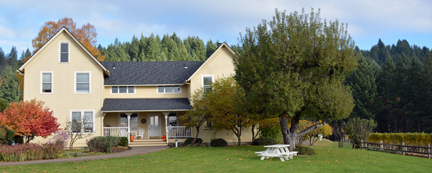 Summary: Off a secondary road, wine enthusiasts travel along a tree lined, meandering gravel road. The trees give way to vineyards, some bright yellow in late November. Stop for a moment and observe vineyards planted in the mid-1960s. These fifty year old vines are making remarkable wines. The tasting room is a bit further down the road, on the first floor of a restored farmhouse.
Summary: Off a secondary road, wine enthusiasts travel along a tree lined, meandering gravel road. The trees give way to vineyards, some bright yellow in late November. Stop for a moment and observe vineyards planted in the mid-1960s. These fifty year old vines are making remarkable wines. The tasting room is a bit further down the road, on the first floor of a restored farmhouse.
We visited David Hill Vineyard and Winery during Thanksgiving week. The late November air was crisp and the cloudy skies did not deter from the bright yellow color of a 1965 Gewürztraminer vineyard. We stopped to capture the scene before proceeding to the tasting room. Later, we learned that the older vines on the property hold onto their leaves until later in autumn. For the younger vines, late autumn and winter afford an opportunity to view a vine architecture. In 2015, David Hill Vineyard and Winery celebrated its 50th anniversary. Wines from those older vines were a showcase of our visit.
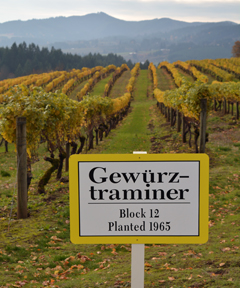 History
History
Prior to the first planting of grape vines on the property in 1965, the land was called David’s Hills, named after the Federick David family. Charles “Chuck” Coury purchased the land in 1965 and experimented with vineyard plantings. He planted some of the first Pinot Noir in Oregon. He likened the area to the Alsace region of France and Coury also planted Gewürztraminer and Riesling. Coury developed a clone of Pinot Noir that bears his name “Coury Clone.”
The winery was not as profitable as Coury wished and Coury went to Portland where he was one of the first craft brewers in the Pacific Northwest. Le later left Oregon for California to brew beer. The land was dormant for years until in 1992 Milan and Jean Stoyanov purchased the property. They made extensive renovations to the farm house that dates from 1883 to the winery and vineyard. The Stoyanov’s created the David Hill label and their first vintage was released in 2000. The original vineyards that Coury planted in 1965 are still in production making the vineyards among the oldest in Oregon.
Vineyards
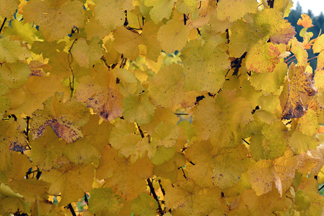 The winery and vineyard property comprises of 150 acres of which 43 acres are under vine. The Laurelwood soil is between 360 and 625 feet in elevation. The soil has a volcanic base and a covering of wind blown loess over the base. From the 1965 era, 14 acres have survived. These acres planted by Charles Coury include Pinot Noir, Pinot Blanc, Riesling and Gewürztraminer. Other varieties have also been planted on the property including Pinot Gris, Chardonnay, Sylvaner, Muscat and Semillon Blanc. An additional 15 acres of vineyards are planned over the next few years.
The winery and vineyard property comprises of 150 acres of which 43 acres are under vine. The Laurelwood soil is between 360 and 625 feet in elevation. The soil has a volcanic base and a covering of wind blown loess over the base. From the 1965 era, 14 acres have survived. These acres planted by Charles Coury include Pinot Noir, Pinot Blanc, Riesling and Gewürztraminer. Other varieties have also been planted on the property including Pinot Gris, Chardonnay, Sylvaner, Muscat and Semillon Blanc. An additional 15 acres of vineyards are planned over the next few years.
Most grapes are used in the winery’s production; however, there are some grapes sold to other wineries. We met Mike Kuenz, general manager and vineyard manager. Mike took us on a walk through the vineyard pointing out the original vines planted in the mid-1960s. These were easy to identify since they still had their leaves on them. We also observed some of the Coury clone Pinot Noir vines.
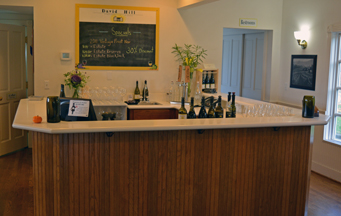 Tasting Room
Tasting Room
The tasting room is located in a restored farmhouse built in 1883. A U-shaped tasting counter can accommodate several people in the main room that also serves as a retail area. An adjacent room is larger and tables and benches are available for additional space for tasting the wines. At the end of this room, one can observe the different soils common in the Willamette Valley. The largest soil jar contains the Laurelwood soil from this property.
Winemaking and Wine Tasting
Jason Bull has crafted wines at David Hill Vineyard and Winery since 2005. The winery produces about 7,000 cases of wine under three series: the Estate Series, The Black Label Series and the Port Series.
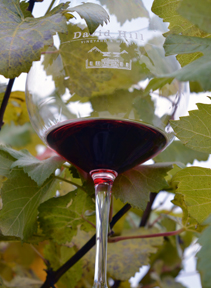 Mike led our tasting experience and concentrated on the wines made from the older vines on the property. All wines tasted were estate and in the Willamette Valley AVA.
Mike led our tasting experience and concentrated on the wines made from the older vines on the property. All wines tasted were estate and in the Willamette Valley AVA.
We began with the 2014 Estate Pinot Blanc. The light yellow colored wine had 12.1% alcohol. The aroma was clean, fresh and citrusy. The taste offered citrus and tropical fruits. The fruity finish had some mineral notes. The 2014 Estate Gewürztraminer was also a light yellow color with 12.1% alcohol. There was a bit of sweetness in this wine measuring at 18 grams/liter of residual sugar. There was a floral aroma and the taste reminded me of tropical fruits and flowers, notably roses. There was a faint hint of petrol also on the taste. The finish had layers of fruit and floral components. The 2014 Estate Riesling was a bit sweeter with 20 grams/liter of residual sugar. The light yellow colored wine had 13.5% alcohol. There were floral and mineral notes on the aroma, while the taste offered peach and floral notes. The crisp finish had layers of fruit and floral hints.
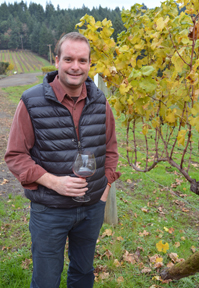 For the first Pinot Noir, Mike (pictured left) decided to have us compare and contrast the wine glasses. The Riedel Oregon Pinot Noir glass and the Riedel Burgundy Pinot Noir Glass were used. The 2012 Estate Reserve Pinot Noir was a blend of three Pinot Noir clones. The wine showcased differently in each glass. Although the Oregon Pinot Noir glass is popular in Oregon, the Pinot Noir did not perform as well as it did in the Burgundy glass. Mike thought this was due to the vines planted in a volcanic base soil. In the Burgundy glass the aroma offered red berry fruits, while in the Oregon glass there was more of an influence of oak and the fruit was minimal. The same was observed on the taste, with the Burgundy glass presenting red raspberries and leather while the Oregon glass hadnlittle fruit. In both glasses the wine showcased a medium body and mild tannins. The finish was more fruity in the Burgundy glass and more oaky in the Oregon glass.
For the first Pinot Noir, Mike (pictured left) decided to have us compare and contrast the wine glasses. The Riedel Oregon Pinot Noir glass and the Riedel Burgundy Pinot Noir Glass were used. The 2012 Estate Reserve Pinot Noir was a blend of three Pinot Noir clones. The wine showcased differently in each glass. Although the Oregon Pinot Noir glass is popular in Oregon, the Pinot Noir did not perform as well as it did in the Burgundy glass. Mike thought this was due to the vines planted in a volcanic base soil. In the Burgundy glass the aroma offered red berry fruits, while in the Oregon glass there was more of an influence of oak and the fruit was minimal. The same was observed on the taste, with the Burgundy glass presenting red raspberries and leather while the Oregon glass hadnlittle fruit. In both glasses the wine showcased a medium body and mild tannins. The finish was more fruity in the Burgundy glass and more oaky in the Oregon glass.
For the remainder of our vertical Pinot Noir tastings, we used the Burgundy Pinot Noir glass. The wines were all made with the Coury clone Pinot Noir. The 2008, a warm year, Black Jack Pinot Noir was an opaque dark ruby color with 14.3% alcohol. There were blackberries and black raspberries on the aroma and taste. The wine was full-bodied with medium to bold tannins. The finish was fruity with hints of leather. In contrast, the 2009, a cool year, Black Jack Pinot Noir was a translucent ruby color with 13.8% alcohol. The aroma and taste were red berry fruit most notably raspberries. This medium-bodied wine had medium tannins. It had a crisp finish of fruit yielding to leather.
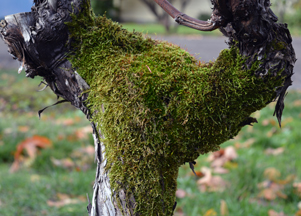 The 2011, also a cool year, Black Jack Pinot Noir was a translucent ruby color at 13.0% alcohol.Red raspberries were on the aroma and taste. The medium-bodied wine had medium tannins. It had a crisp fruit finish. In comparison the 2012, a warmer year, Black Jack Pinot Noir was an opaque dark ruby color with 13.8% alcohol. The aroma and taste included blackberries and red raspberries. The wine was full-bodied with medium to bold tannins. The fruity finish yielded to leather and mineral.
The 2011, also a cool year, Black Jack Pinot Noir was a translucent ruby color at 13.0% alcohol.Red raspberries were on the aroma and taste. The medium-bodied wine had medium tannins. It had a crisp fruit finish. In comparison the 2012, a warmer year, Black Jack Pinot Noir was an opaque dark ruby color with 13.8% alcohol. The aroma and taste included blackberries and red raspberries. The wine was full-bodied with medium to bold tannins. The fruity finish yielded to leather and mineral.
A visit to David Hill Vineyard and Winery offers a look at the history of wine in the Willamette Valley. You can see this history in the vineyards and taste it in the wines.
David Hill Winery
46350 NW David Hill Rd
Forest Grove, Oregon 97116
GPS: N45º 32.869’ W123º 09.462’
Article written December 2015
Support the following Oregon Wineries.
 |
 |
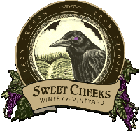 |
|
| Civic Winery | King Estate | Sweet Cheeks Winery & Vineyard | |
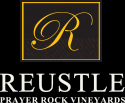 |
|||
| Reustle Prayer Rock Vineyard | Youngberg Hill |
